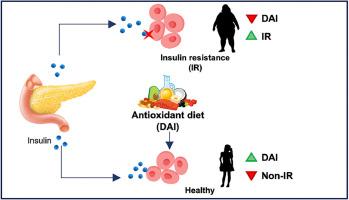High dietary antioxidant index associated with reduced insulin resistance in female Mexican children and adolescents
IF 3.4
3区 医学
Q2 NUTRITION & DIETETICS
引用次数: 0
Abstract
Antioxidant intake is inversely associated with different health outcomes; however, its association with insulin resistance (IR) has not been well documented. We hypothesized that the Dietary Antioxidant Index (DAI) is inversely associated with IR in Mexican children and adolescents. A cross-sectional analysis was performed using data from the Health Workers Cohort Study. A total of 830 children and adolescents aged 7 to 18 years were enrolled. The DAI was evaluated in three categories defined by tertiles using a semiquantitative food frequency questionnaire. IR was defined using previously reported cutoff points in the homeostasis model assessment. This association was evaluated using a multiple logistic regression model. Stratified analysis was performed using body mass index and sex. The prevalence of IR based on the DAI categories (low, medium, high) was 23.8%, 24.2%, and 15.3%, respectively. The IR odds ratio (OR) for participants in the highest DAI category was 0.49 (95% confidence interval [CI]: 0.30-0.80). Notably, female Children and Adolescents in the highest DAI category had significantly lower odds of developing IR than those in the lowest DAI category (OR 0.54, 95% CI 0.29-0.98). Participants with overweight/obesity showed a similar association (OR 0.37, 95% CI 0.18-0.76). These results suggest that the DAI is inversely associated with IR, particularly in females, highlighting the potential role of antioxidants in preventing IR. This underscores the need to establish recommendations for antioxidant consumption in female children and adolescents.

高膳食抗氧化指数与降低墨西哥女性儿童和青少年的胰岛素抵抗有关。
抗氧化剂的摄入量与不同的健康结果成反比;然而,其与胰岛素抵抗(IR)的关系还没有得到很好的记录。我们假设膳食抗氧化剂指数(DAI)与墨西哥儿童和青少年的胰岛素抵抗成反比关系。我们利用卫生工作者队列研究(Health Workers Cohort Study)的数据进行了横断面分析。研究共招募了 830 名 7 至 18 岁的儿童和青少年。使用半定量食物频率问卷对DAI进行了评估,分为三个等级。IR的定义采用了之前报道的平衡模型评估的临界点。使用多元逻辑回归模型对这种关联进行了评估。根据体重指数和性别进行了分层分析。基于 DAI 类别(低、中、高)的 IR 患病率分别为 23.8%、24.2% 和 15.3%。DAI值最高的参与者的IR几率比(OR)为0.49(95%置信区间[CI]:0.30-0.80)。值得注意的是,DAI值最高的女性儿童和青少年患IR的几率明显低于DAI值最低的儿童和青少年(OR 0.54,95% CI 0.29-0.98)。超重/肥胖的参与者也有类似的关联(OR 0.37,95% CI 0.18-0.76)。这些结果表明,DAI与IR成反比关系,尤其是在女性中,突出了抗氧化剂在预防IR中的潜在作用。这凸显了为女性儿童和青少年制定抗氧化剂消费建议的必要性。
本文章由计算机程序翻译,如有差异,请以英文原文为准。
求助全文
约1分钟内获得全文
求助全文
来源期刊

Nutrition Research
医学-营养学
CiteScore
7.60
自引率
2.20%
发文量
107
审稿时长
58 days
期刊介绍:
Nutrition Research publishes original research articles, communications, and reviews on basic and applied nutrition. The mission of Nutrition Research is to serve as the journal for global communication of nutrition and life sciences research on diet and health. The field of nutrition sciences includes, but is not limited to, the study of nutrients during growth, reproduction, aging, health, and disease.
Articles covering basic and applied research on all aspects of nutrition sciences are encouraged, including: nutritional biochemistry and metabolism; metabolomics, nutrient gene interactions; nutrient requirements for health; nutrition and disease; digestion and absorption; nutritional anthropology; epidemiology; the influence of socioeconomic and cultural factors on nutrition of the individual and the community; the impact of nutrient intake on disease response and behavior; the consequences of nutritional deficiency on growth and development, endocrine and nervous systems, and immunity; nutrition and gut microbiota; food intolerance and allergy; nutrient drug interactions; nutrition and aging; nutrition and cancer; obesity; diabetes; and intervention programs.
 求助内容:
求助内容: 应助结果提醒方式:
应助结果提醒方式:


